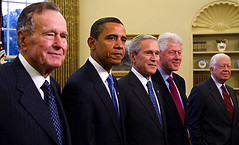
Image by BL1961 via Flickr
By Ruy Teixeira | March 11, 2009
During the 2008 presidential campaign, Barack Obama ran on a strongly progressive program that included a promise of universal health care coverage, a dramatic transformation to a low-carbon economy, and a historic investment in education—alongside broad hints that substantial government spending and regulation would be required to deal with the economic and financial crises. He also promised a new, more cooperative approach to international relations. Obama received 53 percent of the popular vote to 46 percent for his conservative opponent John McCain, and he carried the electoral vote by an even more substantial 365-to-173 margin.
Obama’s 53 percent of the popular vote is the largest share of the popular vote received by any presidential candidate in 20 years. The last candidate to register that level of support was conservative George H.W. Bush, who won by an identical 53 percent-to-46 percent margin. So, separated by 20 years, we have two elections that are practically mirror images of one another, but with conservatives on the winning end of the first and progressives on the winning end of the second.
What happened? How did conservatives do so well in one election but progressives so well in the other? The answer: In those intervening 20 years, a new progressive America has emerged with a new demography, a new geography, and a new agenda.
The new demography refers to the array of growing demographic groups that have aligned themselves with progressives and swelled their ranks. The new geography refers to the close relationship between pro-progressive political shifts and dynamic growth areas across the country, particularly within contested states. The new agenda is the current tilt of the public toward progressive ideas and policy priorities—a tilt that is being accentuated by the strong support for this agenda among growing demographic groups.
![Reblog this post [with Zemanta]](http://img.zemanta.com/reblog_a.png?x-id=8ba4bda8-64b7-4ff1-a5ef-2aad0a52fca5)
No comments:
Post a Comment